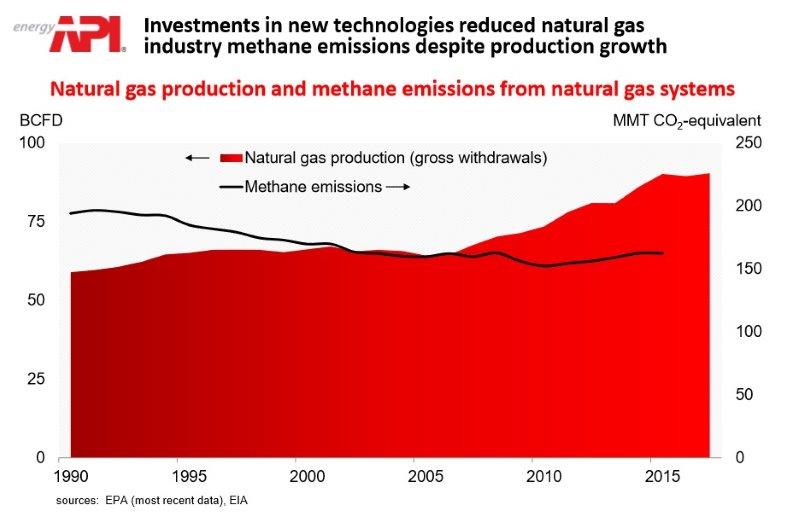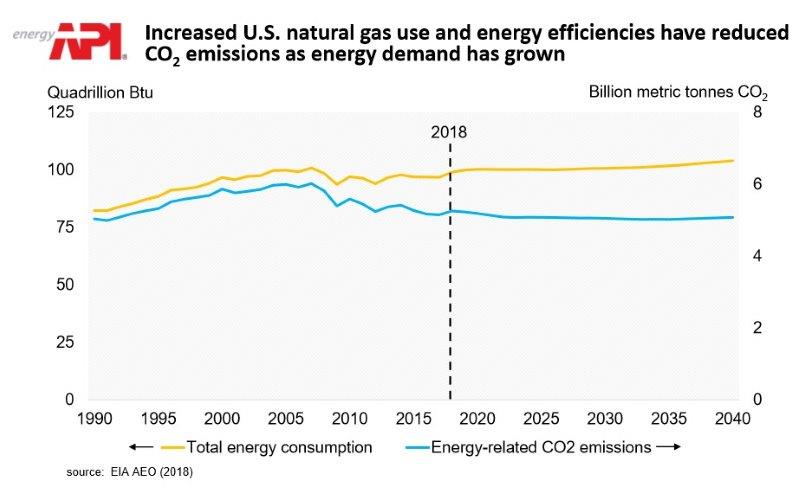The Good News on (Lowering) Emissions
Mark Green
Posted July 9, 2018
There’s good and not-so-good in a recent Washington Post editorial on natural gas and climate policy, which rightly nails the importance of natural gas to the U.S. economy and the environment, yet wrongly suggests more layers of government regulation are needed to further reduce greenhouse gas emissions.
The Good
As the editorial states, hydraulic fracturing and horizontal drilling technologies used to produce natural gas have indeed “revolutionized” the U.S. energy industry:
- The U.S. leads the world in natural gas and oil production.
- Abundant natural gas has benefited consumers with lower energy costs.
- U.S. manufacturing also is enjoying a renaissance thanks to affordable natural gas – providing power and as a feedstock for making for a number of products.
The fact is methane emissions from natural gas production are down 14 percent since 1990, even as natural gas output increased more than 50 percent over the same period.

In addition, increased use of natural gas is the chief reason U.S. emissions of carbon dioxide, a leading GHG source, are at 25-year lows – and a major contributor toward providing Americans with the cleanest air in years.

The Post:
This revolution has the potential to be good for both the economy and the environment, because burning natural gas produces none of the toxic ambient air pollution that burning coal does, and only about half the greenhouse emissions.
As Jude Clemente writes for Real Clear Energy, emissions from the U.S. power sector are the lowest they have been since 1985 – mostly because of natural gas. Clemente:
In fact, the U.S. has slashed CO2 emissions much faster than our European allies that adopted the Kyoto Protocol to reduce emissions in 1997. Preferring markets over incessant regulation, non-signatory U.S. has been reducing emissions faster than any other nation on Earth. All the while, our economy has boomed nearly 60 percent to $18 trillion (real 2010 $).
The Not-So-Good
Unfortunately, the Post editorial says that industry is lackadaisical toward methane emissions associated with producing natural gas, and that more Washington regulation is needed. That’s just false.
Our industry is highly motivated to reduce methane emissions; no one is more focused on it. That’s because capturing methane, the chief component in natural gas, means more natural gas can be provided to customers. In a letter to the editor of the Post, Matt Todd, program director for The Environmental Partnership – more than 40 natural gas and oil companies committed to reducing methane emissions – writes:
America’s natural gas and oil industry is committed to solving environmental challenges, and the data demonstrate our success. … The industry is second only to the federal government in spending on climate innovation and research. That commitment is not dependent on government regulations. … The Environmental Partnership participants implement programs to further target emissions of methane – from leak detection and repair to replacing or retrofitting gas-powered controllers. An annual report – shared with the public – will track success. … Everyone can agree that methane reduction is an important priority, one the U.S. natural gas and oil industry will continue to tackle.
Again, this is happening now. At the recent World Gas Conference, the Environmental Defense Fund’s Fred Krupp acknowledged natural gas is helping make the air cleaner and has the potential to lower greenhouse gas emissions. As noted above, natural gas’ environmental benefits are more than potential. And companies are using technologies and due diligence to cut methane emissions. EQT Corporation’s Rob McNally at the conference:
“We do our best to measure methane releases, and in the last report in 2017 we’re now down to .28 of a percent, so about one-quarter of 1 percent of the gas we produce we think we lose. Five years ago, that number was about triple that. In that time we’ve replaced over 550 pneumatic valves and we’ve really ramped up the monitoring program, using some of the technologies that people have mentioned – satellite technology, drilling technologies – and have spent real time and money fixing pipes and fixing valves, which is the biggest issue for us. We fully agree that as an industry we need to live up to that reputation.”
Southwestern Energy’s Jennifer Stewart, also at WGC2018:
“We approach methane intensity as critical – critical for our employees, the environment and for our shareholders. Our track record has shown that. … We just came out with our methane intensity rate of .175 percent, so we set a goal, actually, in 2014, of trying to reach an intensity rate of .36 or lower and within 10 years, and we met that within one year. … The culture and the leadership of the industry (matters). … One Future, the consortium that we’re in … as well as The Environmental Partnership with API – I believe it’s up to almost 50 participants, which is a huge number – is indicating that voluntary leadership of reducing methane emissions is (happening).”
And that’s the point, reducing emissions – not the Washington political games and reflexive calls for more one-size-fits-all regulation. Industry, which is guided by strong state regulatory regimes and its own field-tested standards and best practices, is committed to lowering methane emissions because there are strong environmental and business incentives to do so. It’s an effective combination that is working and will continue to work – even as Americans benefit from clean, abundant domestic natural gas.
About The Author
Mark Green joined API after a career in newspaper journalism, including 16 years as national editorial writer for The Oklahoman in the paper’s Washington bureau. Previously, Mark was a reporter, copy editor and sports editor at an assortment of newspapers. He earned his journalism degree from the University of Oklahoma and master’s in journalism and public affairs from American University. He and his wife Pamela have two grown children and six grandchildren.


